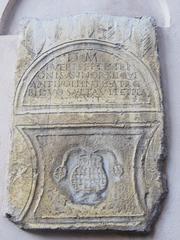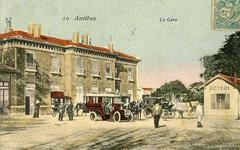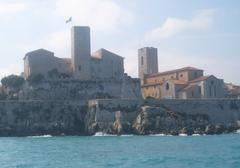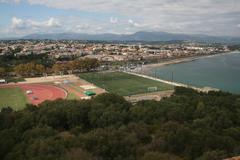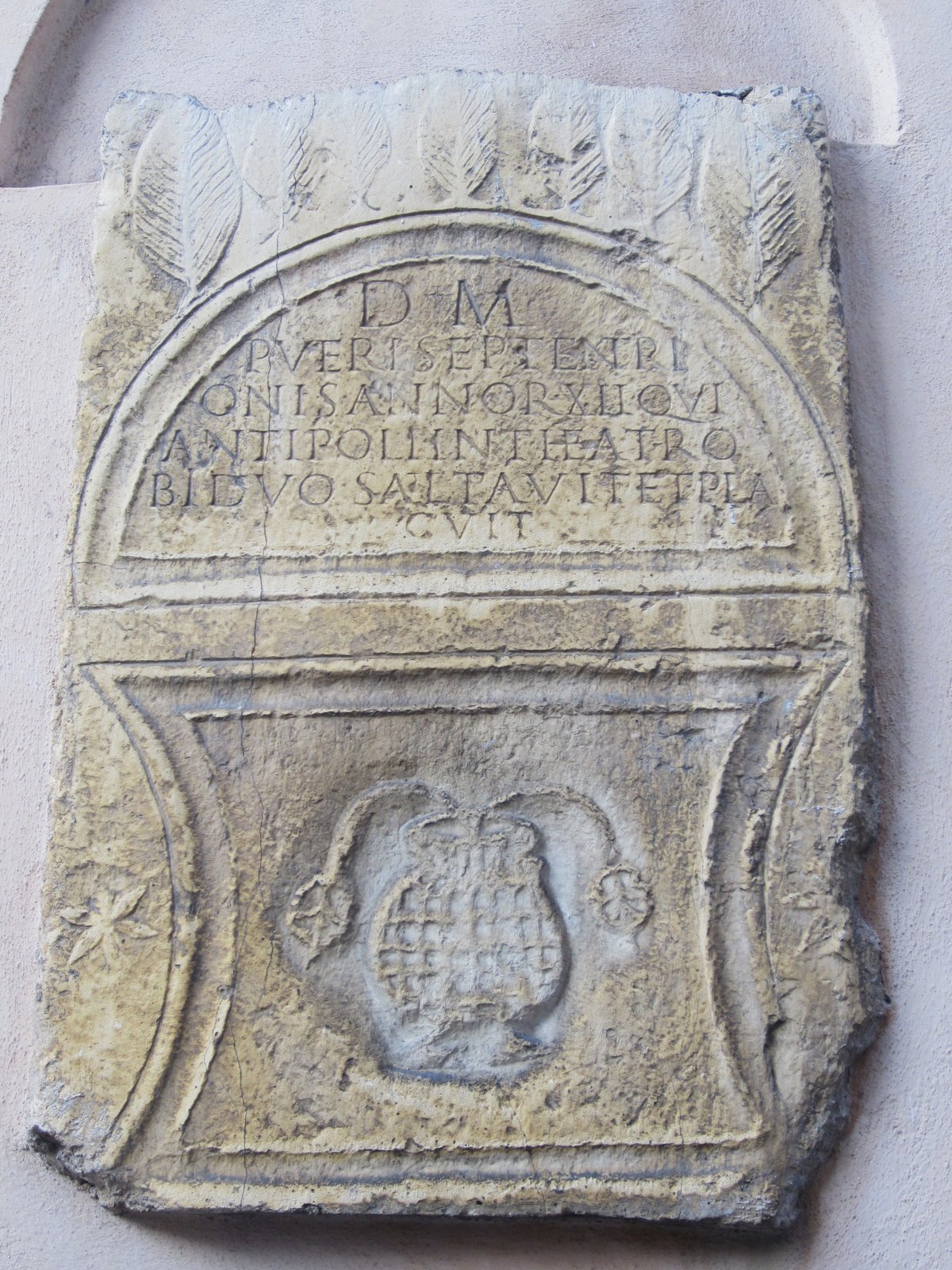
Comprehensive Guide to Visiting Musée d’Archéologie Antibes, France
Date: 31/07/2024
Introduction
Located in the charming town of Antibes, France, the Musée d’Archéologie offers an unparalleled glimpse into the region’s rich archaeological heritage. Established in 1963, the museum is housed in the historic Bastion Saint-André, a fortification dating back to 1698. This museum is a treasure trove for history enthusiasts and casual visitors alike, featuring artifacts that span from the 7th century BCE to the 5th century CE. Visitors can explore everything from ancient shipwrecks and Roman artifacts to remarkable ceramics and funerary items, each telling a unique story of Antibes’ evolution from an indigenous oppidum to a Greek colony and later a Roman city (Explore Nice Côte d’Azur, Provence Lovers).
This comprehensive guide provides all the essential information you need to plan your visit, including the museum’s history, significance, notable exhibits, visiting hours, ticket information, travel tips, and more. Whether you’re keen on delving into ancient history or simply looking for an enriching cultural experience, the Musée d’Archéologie in Antibes promises to be an engaging and educational destination.
Table of Contents
- [Introduction](#introductionintroduction)
- [History and Significance](#history-and-significancehistory-and-significance)
- [Origins and Establishment](#origins-and-establishmentorigins-and-establishment)
- [Historical Milestones](#historical-milestoneshistorical-milestones)
- [Significance in Local and National Heritage](#significance-in-local-and-national-heritagesignificance-in-local-and-national-heritage)
- [Notable Artifacts and Exhibits](#notable-artifacts-and-exhibitsnotable-artifacts-and-exhibits)
- [The Galet de Terpon](#the-galet-de-terponthe-galet-de-terpon)
- [Ceramics Collection](#ceramics-collectionceramics-collection)
- [Roman Artifacts](#roman-artifactsroman-artifacts)
- [Maritime Archaeology](#maritime-archaeologymaritime-archaeology)
- [Funerary Artifacts](#funerary-artifactsfunerary-artifacts)
- [Daily Life in Ancient Antibes](#daily-life-in-ancient-antibesdaily-life-in-ancient-antibes)
- [Visitor Information](#visitor-informationvisitor-information)
- [Visiting Hours](#visiting-hoursvisiting-hours)
- [Ticket Information](#ticket-informationticket-information)
- [Travel Tips](#travel-tipstravel-tips)
- [Accessibility](#accessibilityaccessibility)
- [Educational and Cultural Impact](#educational-and-cultural-impacteducational-and-cultural-impact)
- [FAQ](#faqfaq)
- [Conclusion](#conclusionconclusion)
- [References](#referencesreferences)
History and Significance
Origins and Establishment
The Musée d’Archéologie in Antibes was inaugurated in June 1963, following a surge in archaeological discoveries in the 1950s, particularly numerous shipwrecks. This prompted the local municipality to establish a dedicated space for preserving and showcasing these findings. The museum is housed in the Bastion Saint-André, a fortification constructed in 1698 based on the designs of the renowned military engineer Vauban. This bastion was part of the broader defensive improvements for Antibes and is now a historical monument listed in the Inventaire supplémentaire des Monuments historiques since 1930.
Historical Milestones
The museum’s collection traces its roots back to the 16th century with the discovery and documentation of several Gallo-Roman inscriptions, including the notable stèle de l’enfant Septentrion. By the 19th century, private collections began to form among the local elite, further enriching the archaeological repository. In 1928, Romuald Dor de La Souchère, a Hellenist and professor from Cannes, established the first history museum in the Grimaldi Castle, gathering archaeological artifacts, molds, and extensive documentation.
Significance in Local and National Heritage
The Musée d’Archéologie plays a crucial role in preserving and interpreting the rich historical tapestry of Antibes, known in antiquity as Antipolis. The museum’s exhibits span over ten centuries, from the 7th century BCE to the 5th century CE, offering insights into the region’s evolution from an indigenous oppidum to a Greek colony and later a Roman city.
Notable Artifacts and Exhibits
The Galet de Terpon
One of the museum’s most significant artifacts is the Galet de Terpon, the oldest inscription found in Antibes. This artifact provides a direct link to the ancient worship practices dedicated to the goddess Aphrodite.
Ceramics Collection
The museum boasts an extensive collection of ceramics, including indigenous, Etruscan, Massaliote, and Greek pieces. These ceramics, unearthed from excavations in Vieil-Antibes, illustrate nearly seven centuries of occupation and cultural exchange, from the indigenous oppidum to the Greek colony of Marseille.
Roman Artifacts
The Roman period is well-represented with various artifacts, including two coins from Antipolis, wall paintings depicting birds and Amor, and a marble bust of Dionysos or a faun. These items reflect the city’s development after it gained independence from Marseille in 49 BCE.
Maritime Archaeology
Antibes’ strong maritime heritage is showcased through artifacts recovered from shipwrecks in the Anse Saint-Roch and other sites. These include a variety of amphorae, glass vases, and ceramic tableware, illustrating the city’s role in ancient Mediterranean trade networks. Notable shipwrecks include the Roches d’Aurelle and the Tradelière, which have yielded thousands of well-preserved objects.
Funerary Artifacts
The museum also features a significant collection of funerary artifacts, including glass, lead, and ceramic urns used for cremation remains, as well as a lead sarcophagus and a tile-built tomb. These items, along with the mausoleum fragments from Vallauris, provide insights into ancient burial practices and beliefs in the afterlife.
Daily Life in Ancient Antibes
The museum’s exhibits also delve into the daily life of ancient Antibes’ inhabitants. Artifacts from the Rue Clemenceau excavations, conducted between 1992 and 1994, include a mosaic with hexagonal patterns and a marble fountain, both of which adorned a notable’s residence in the late 2nd century CE. These findings highlight the advanced infrastructure, including lead water pipes, that supported urban life.
Visitor Information
Visiting Hours
The Musée d’Archéologie is open from Tuesday to Sunday. General visiting hours are from 10 AM to 6 PM, but it’s advisable to check the official website for any changes or special holiday hours.
Ticket Information
General admission tickets are priced at €6 for adults. Reduced rates are available for students, seniors, and groups. Children under 12 can enter for free. For the latest pricing and to purchase tickets online, visit the museum’s official website.
Travel Tips
The museum is easily accessible by public transport, with several bus routes stopping nearby. Parking is available for those driving, but spaces can be limited during peak tourist seasons. Consider exploring other nearby attractions such as the Picasso Museum, the Antibes Cathedral, and the scenic Old Town.
Accessibility
The museum is wheelchair accessible, with ramps and elevators to ensure all visitors can enjoy the exhibits. Assistance dogs are welcome, and special tours can be arranged for visitors with disabilities.
Educational and Cultural Impact
The Musée d’Archéologie not only preserves historical artifacts but also serves as an educational resource. The museum employs various didactic tools, photographs, and maps to enhance visitors’ understanding of Antibes’ ancient history. This educational approach ensures that the museum remains a vital cultural institution, fostering a deeper appreciation of the region’s rich archaeological heritage.
FAQ
Q: What are the Musée d’Archéologie’s visiting hours? A: The museum is open from Tuesday to Sunday, 10 AM to 6 PM.
Q: How much are the tickets? A: General admission is €6 for adults, with reduced rates for students, seniors, and groups. Children under 12 enter for free.
Q: Is the museum accessible for visitors with disabilities? A: Yes, the museum is wheelchair accessible and offers special tours for visitors with disabilities.
Conclusion
In summary, the Musée d’Archéologie in Antibes is a cornerstone of local and national heritage, offering a comprehensive glimpse into the ancient past through its extensive and well-preserved collections. The museum’s historical significance, coupled with its educational initiatives, makes it an essential destination for anyone interested in the rich archaeological history of the Mediterranean region. Plan your visit today and immerse yourself in the fascinating history of Antibes.
References
- Explore Nice Côte d’Azur. (n.d.). Visit Musée d’Archéologie. Retrieved from Explore Nice Côte d’Azur
- Provence Lovers. (n.d.). Visit Museum Archaeology Antibes. Retrieved from Provence Lovers
- SeeAntibes. (n.d.). Musée d’Archéologie. Retrieved from SeeAntibes
